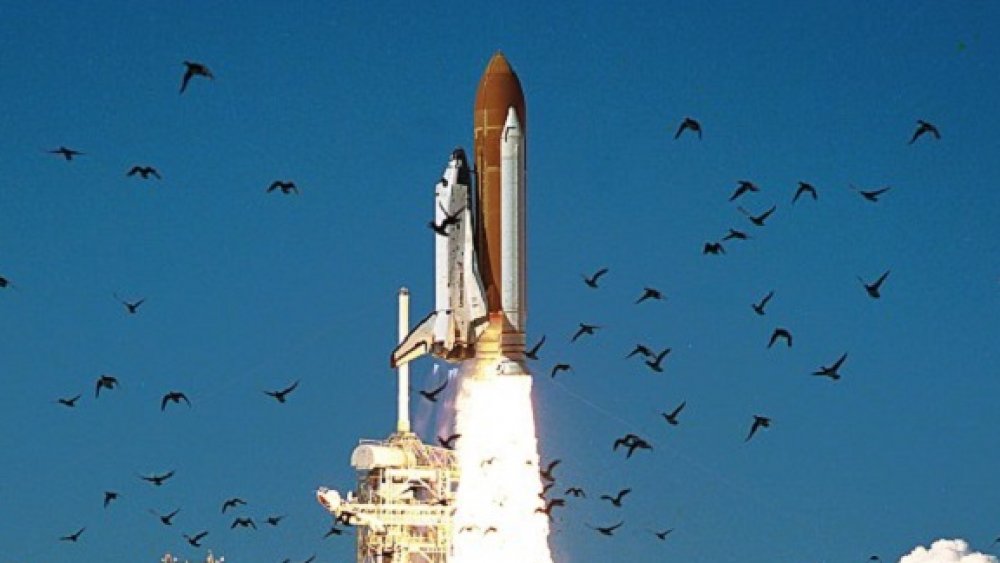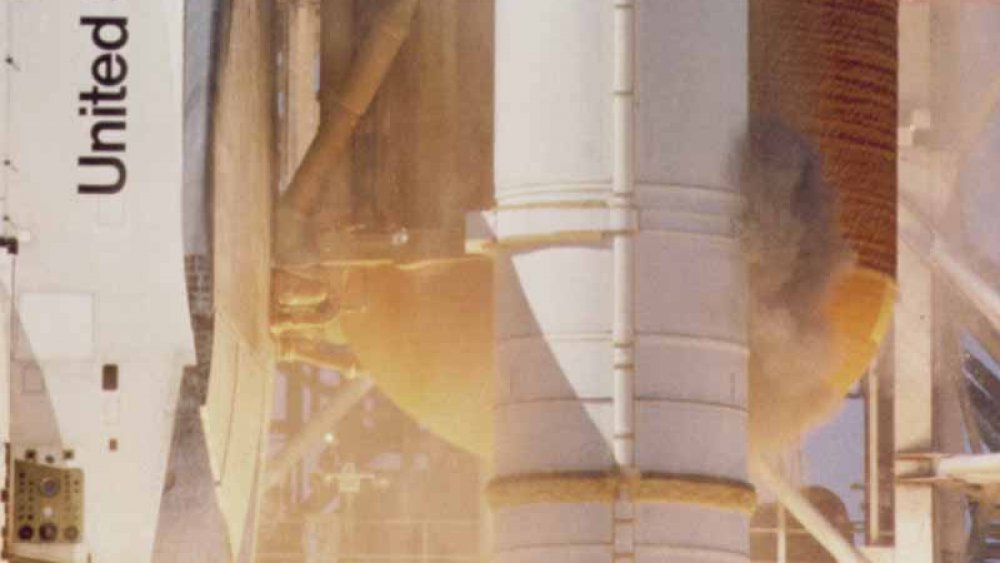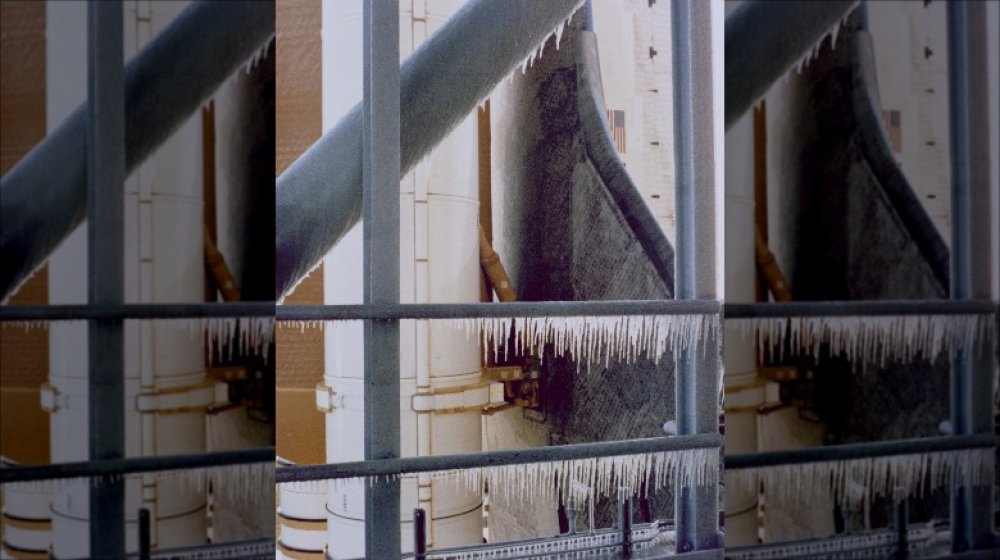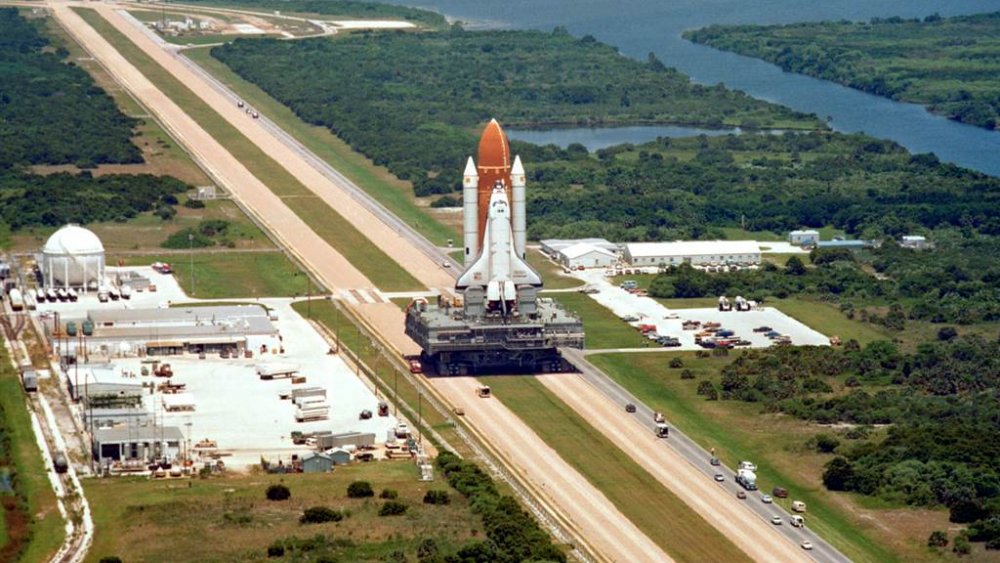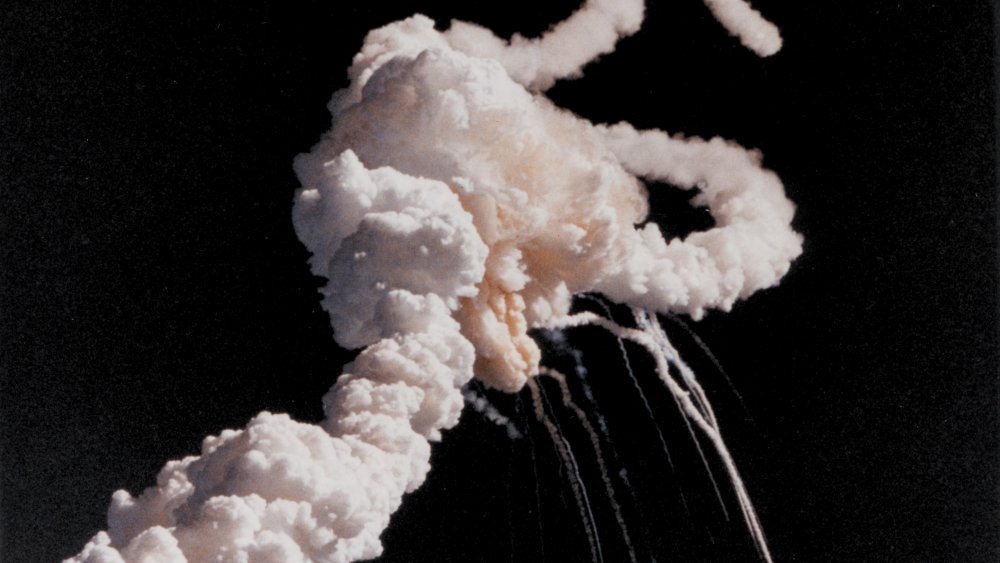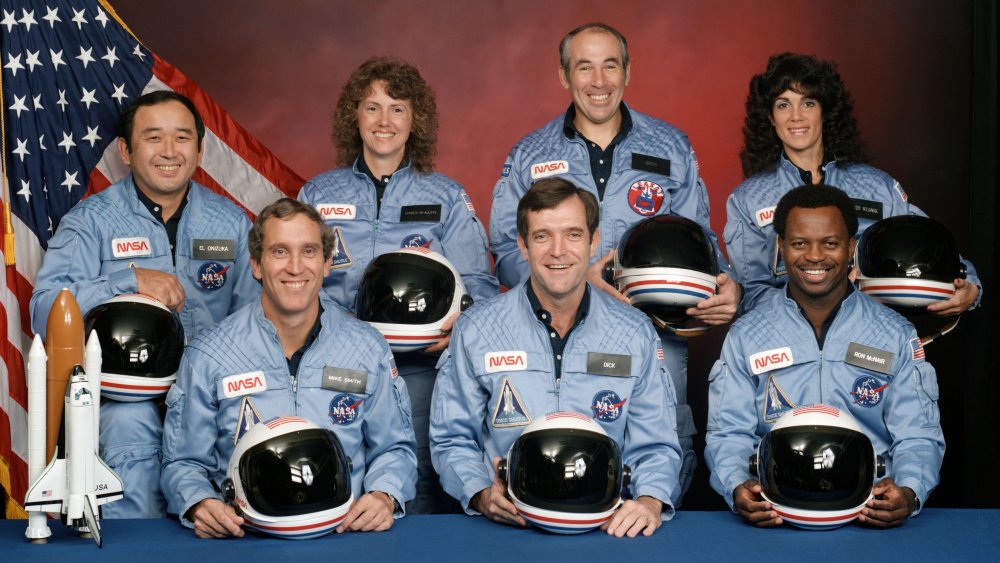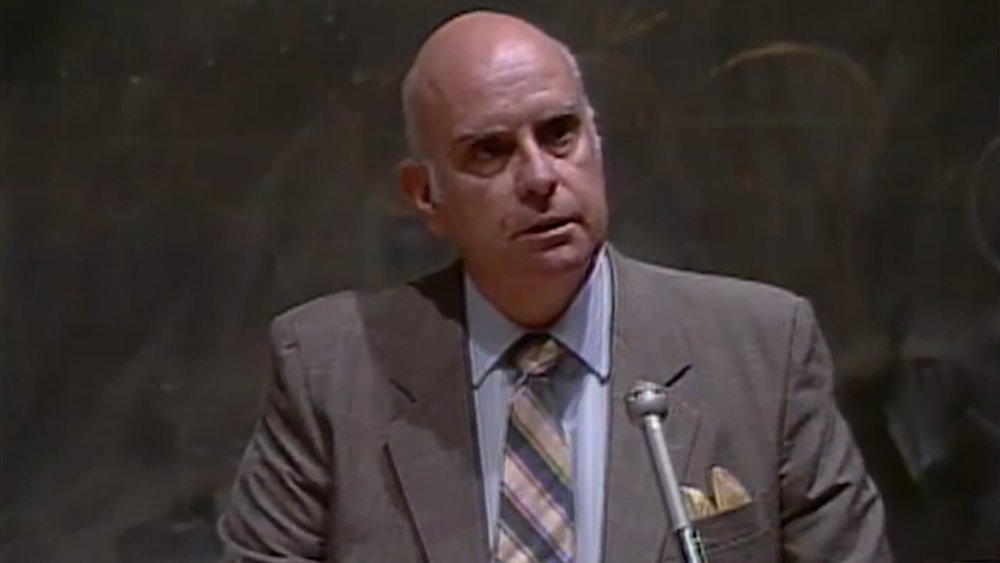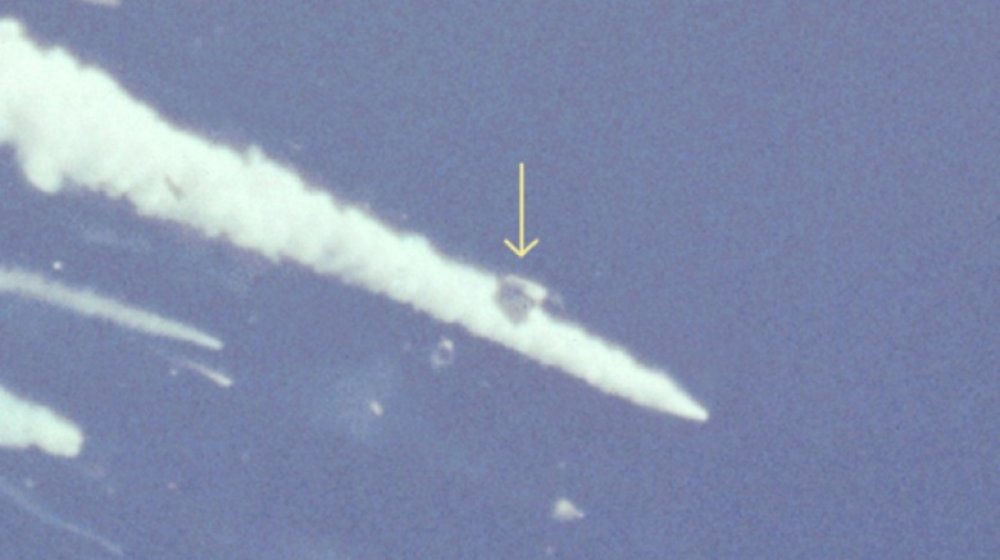The Worst Part Of The Space Shuttle Challenger Disaster Isn't What You Think
On the morning of January 28, 1986, the space shuttle Challenger lifted off from Florida's Kennedy Space Center. The shuttle program was in full swing in the mid-1980s, and NASA's latest mission appeared to be off to a fine start. But then, 73 seconds into the launch, the orbiter was engulfed in a fireball and torn apart, its pieces falling back to Earth. All seven of the astronauts on board — Dick Scobee, Ellison Onizuka, Judith Resnik, Mike Smith, Greg Jarvis, Ron McNair, and Christa McAuliffe — were killed in the disaster.
McAuliffe's death struck an especially poignant chord. She'd been the first teacher to ever be selected to go into space, and her death was witnessed live by her family, her students, and schoolchildren across the country. That's horrible enough, but as with many tragedies, there are further layers to the story. As you're about to see, the worst part of the Space Shuttle Challenger disaster may not be what you think.
NASA knew about the O-ring problems well in advance
Challenger was destroyed due to a faulty O-ring seal in one of its booster rockets, allowing burning gas to escape. The rubber O-rings, of which there were a primary and secondary between each rocket segment, weren't supposed to be burned by the gases resulting from liftoff, but that's exactly what happened during the testing phase. Shockingly, according to the Rogers Commission Report, when it was found that the O-rings could be damaged, engineers at both NASA and Morton Thiokol, the company contracted to design and build the rockets, decided that the situation was undesirable but acceptable.
A test in 1977 revealed another ominous problem — rocket ignition could cause parts of the rocket's steel casing to bend outward, reducing the pressure on the O-rings. The opposite was supposed to happen, with parts bending inward and helping the O-rings to seal properly. At this point, engineers began to sound the alarm. One characterized the current design as "unacceptable" in October 1977, and another stated in January 1978 that redesign was necessary to "prevent hot gas leaks and resulting catastrophic failure." Despite this, nothing was changed.
NASA had more than theory to go on after its second shuttle mission, when Columbia flew in November 1981. When they recovered and examined the shuttle's right rocket booster, one of its primary O-rings had been eroded badly, news that was ultimately met with no action. Multiple subsequent shuttle missions during the 1980s showed O-ring damage, yet still, the design wasn't changed.
The Challenger launched despite warnings about the cold
By 1985, engineers at Morton Thiokol had another concern about the O-rings, namely that they would lose elasticity in cold weather. Given that NASA's bevy of planned shuttle missions included winter launches, this was a problem. As told by NASA Space Flight, one of the engineers, Bob Ebeling, wrote a memo in October 1985 and titled it "Help!" in the hope of finally drawing attention to the issue. No help came.
On January 27, 1986, NASA called Morton Thiokol and asked how they felt about a launch in 18-degree weather. The engineers were aghast. The O-rings' lower threshold of safety was 40 degrees Fahrenheit. Ebeling called his team together, and they all agreed that a launch in such a temperature would be the death of the shuttle crew. In a teleconference with NASA, the engineers laid out why Challenger should not be launched the next morning and recommended that it not lift off in any temperature lower than 53. As engineer Roger Boisjoly later recounted (via NPR), a NASA official was "appalled" at the thought of waiting so long to launch.
The clear, cold weather that night led to ice forming all over the launch pad, but NASA decided to proceed. Per the Rogers Commission Report, the crew were told about the ice when they were briefed on the weather that morning, but they weren't told about any concerns regarding the temperature's effect on the O-rings. The mission was a go.
The Challenger would've lifted off in better conditions if not for a string of delays
As detailed by the Rogers Commission Report, Challenger's launch was scrubbed repeatedly for one reason or another. Had even one of those delays not occurred, the shuttle might've lifted off in safer temperatures. First, it was moved from January 22 to January 23 due to schedule ripples caused by the prior delay of another mission, STS-61-C, and then the Program Requirements Change Board moved liftoff to January 25. After that, the aftereffects of STS-61-C's delay bumped Challenger again to January 26.
The evening before the new launch date, the mission was pushed off yet again due to a forecast of wind and rain, which turned out to be entirely wrong. As Gene Thomas, launch director for the Challenger mission, later recalled, "We decided we would not launch on Sunday, and Sunday was a beautiful day. We missed an opportunity to launch."
Challenger's crew were strapped in and ready to go on the morning of January 27 when another problem reared its head. A screw wouldn't release from the shuttle's crew hatch. A drill was brought in, but its battery was dead. According to NASA Space Flight, nine more batteries were brought to the launch pad, and for reasons unknown, every single one went dead. Liftoff was finally pushed back one more time ... to the very cold morning of January 28.
A brief glimmer of false hope
At 11:39 AM on January 28, Challenger launched from Kennedy Space Center on what would be a short, doomed flight. Footage later showed that dark smoke began to jet from one of the right-side solid rocket booster's (SRB's) O-rings less than a second after liftoff began. The shuttle broke the sound barrier 40 seconds up, and at around 59 seconds, a plume of flame began to issue from the right-hand SRB. The crew wouldn't have known about this, as further evidenced by their yells of "Wooooo hooooo!" at 60 seconds, a mere quarter-second before the flame began to contact the orbiter's massive external fuel tank. Per Spaceflight Now, even if the crew had known what was happening, there was nothing they could've done.
Just before 73 seconds came the last words from Challenger, spoken by Mike Smith: "Uh-oh." Immediately afterward, the shuttle was torn apart as the external fuel tank erupted into a massive fireball. A few seconds later, an object was seen descending slowly via parachute. As noted by Popular Mechanics, several TV stations began to focus on footage of the object in the shock and confusion that followed. However, it was only the nose cap of one of the SRBs.
The Challenger crew never could've escaped
Anyone in the know wouldn't have focused on the parachuting nose cap for long because there was no way for the Challenger crew to have escaped from the shuttle. The Rogers Commission Report noted that Columbia had ejection seats similar to those of an SR-71 Blackbird for its four test flights early on, but that was when only two people were flying. The seats were never meant to be in place for the actual shuttle missions, when it was assumed that all risks would've been accounted for and resolved.
NASA had, in fact, considered full crew ejection options back in 1971 when the shuttle was being designed, examining the feasibility of conventional ejection seats, encapsulated seats, and a whole detachable crew compartment. The problem was the cost of integrating any of these options into the design. Open seats would've cost $10 million, encapsulated seats would've cost $7 million, and the crew compartment option would have added a whopping $292 million to the bill. After the Challenger disaster, the idea of an astronaut escape system was examined once again. A number of designs were considered, but as before, all of them were ultimately rejected due to the difficulty of their implementation.
The grim recovery
Per the Rogers Commission Report, recovery efforts began within an hour of Challenger's breakup, but the crew wouldn't be found until March 1986. Off the Florida coast, two divers came across the crew cabin on the seabed approximately 100 feet below the surface. It was a wreck of twisted metal and wires, and the divers didn't know what they'd found until they saw a spacesuit bobbing in the water. Low on air, the two men marked the location and swam for the surface.
The next day, the USS Preserver came to recover the lost astronauts. As detailed by NBC News, that was easier said than done. Between the crash and the time spent underwater, their remains weren't in good shape, having at times to be removed in parts. First, Judy Resnik was recovered, followed by Christa McAuliffe. After this, it was determined that the jagged, jumbled cabin would have to be raised from the ocean in order to continue.
As a crane pulled the cabin to the ship, a splash of blue appeared on the surface. It was the jump-suited body of Gregory Jarvis, which had come free as the cabin was raised. As the crew of the Preserver watched in dismay, it sank below the waves again. A search for Jarvis immediately ensued, during which astronaut Robert Crippen even hired his own boat to help, but Jarvis wouldn't be found again for another five weeks, 200 yards from where he'd been lost.
The engineers who tried to stop the launch blamed themselves
After failing to convince NASA to stop Challenger's January 28 launch, Morton Thiokol engineer Roger Boisjoly went home. Upon being asked by his wife what was wrong, he responded, "Oh nothing, honey, it was a great day, we just had a meeting to go launch tomorrow and kill the astronauts, but outside of that, it was a great day." As detailed by NASA Space Flight, Boisjoly, fearing the worst, had no intention of watching the launch, but fellow engineer Bob Ebeling convinced him to do so. When the shuttle seemed to lift off just fine, a wave of relief washed over the engineers ... until they saw the fireball. Everyone present knew just what had happened.
Despite his efforts, Boisjoly felt responsible for the seven astronauts' deaths, as did Ebeling. Over the following months, the once-bulky Boisjoly lost quite a bit of weight and became plagued by headaches, insomnia, and depression. He testified to the Rogers Commission and also sued both NASA and Morton Thiokol. However, his lawsuits weren't successful, and Boisjoly's actions led to his shunning by some of his colleagues, worsening his despair. As told by his wife to NPR, Boisjoly did eventually find peace, however, through speaking to engineering schools about the disaster, which he continued to do until his death in January 2012.
The Challenger crew may have been conscious as they fell to Earth
According to a report by NASA scientist Joseph P. Kerwin, when the Challenger broke apart, its crew, protected by the cabin, wouldn't have been killed or even seriously injured, a fact which begs a somber question: Were they still conscious as they fell toward the sea? The answer is unclear.
After the orbiter was torn apart, the sturdy crew cabin (pictured) began to free fall. The central question is how quickly the cabin depressurized. If it did so right away, the astronauts would've been mercifully unaware of their descent after only a few seconds. On the ocean floor, the cabin was a mangled mess, but that was due to its impact. Given the damage, it couldn't be determined whether there'd been any breach in the cabin before the crash.
There is one chilling indicator of the crew's fate. Of the four personal egress air packs, or PEAPs, that were recovered, three had been activated before the impact. However, Kerwin noted that the PEAPs may have been activated "instinctively" due to depressurization right at breakup, in which case they wouldn't have kept the astronauts awake, as they only provided regular air. For what it's worth, per NBC News, three-time shuttle commander Robert Overmeyer, who participated in the cabin's recovery, is certain that the Challenger astronauts were conscious. Whatever happened, there was no chance of survival when the cabin struck the ocean at 207 miles per hour.
